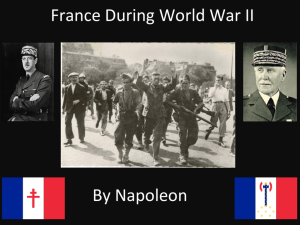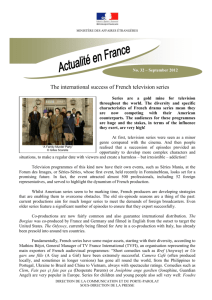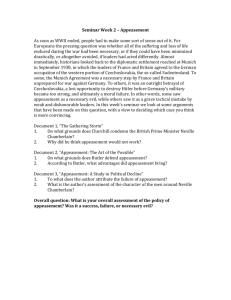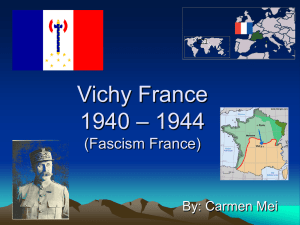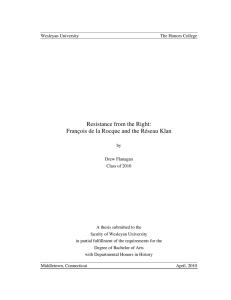The Beginning of WWII
advertisement
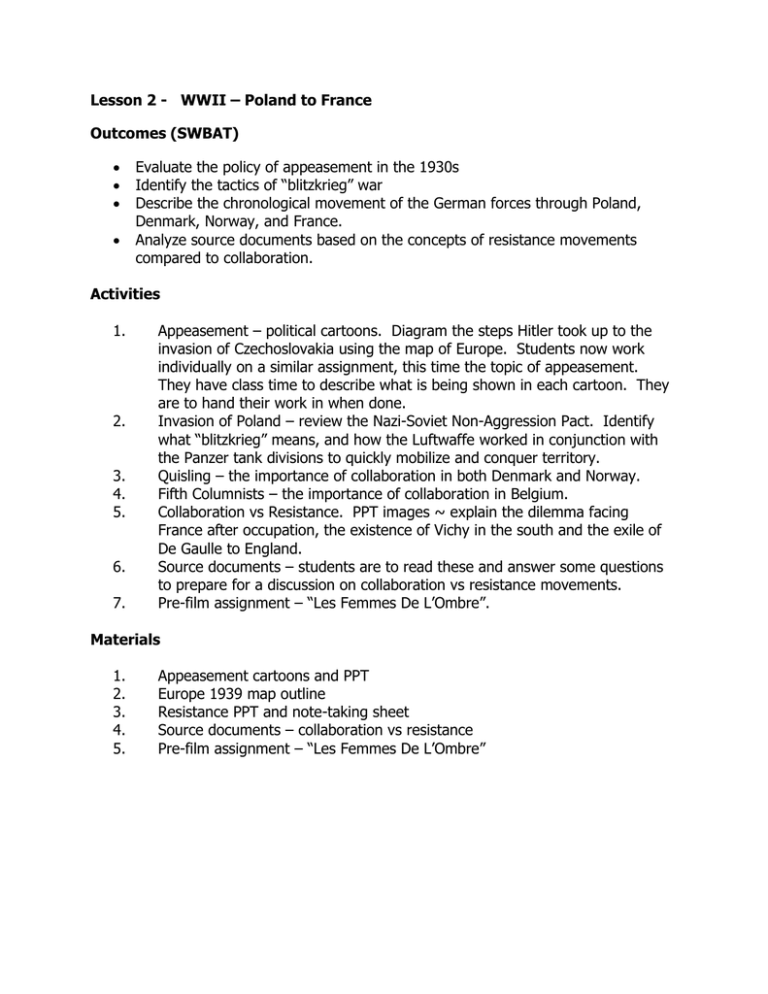
Lesson 2 - WWII – Poland to France Outcomes (SWBAT) Evaluate the policy of appeasement in the 1930s Identify the tactics of “blitzkrieg” war Describe the chronological movement of the German forces through Poland, Denmark, Norway, and France. Analyze source documents based on the concepts of resistance movements compared to collaboration. Activities 1. 2. 3. 4. 5. 6. 7. Appeasement – political cartoons. Diagram the steps Hitler took up to the invasion of Czechoslovakia using the map of Europe. Students now work individually on a similar assignment, this time the topic of appeasement. They have class time to describe what is being shown in each cartoon. They are to hand their work in when done. Invasion of Poland – review the Nazi-Soviet Non-Aggression Pact. Identify what “blitzkrieg” means, and how the Luftwaffe worked in conjunction with the Panzer tank divisions to quickly mobilize and conquer territory. Quisling – the importance of collaboration in both Denmark and Norway. Fifth Columnists – the importance of collaboration in Belgium. Collaboration vs Resistance. PPT images ~ explain the dilemma facing France after occupation, the existence of Vichy in the south and the exile of De Gaulle to England. Source documents – students are to read these and answer some questions to prepare for a discussion on collaboration vs resistance movements. Pre-film assignment – “Les Femmes De L’Ombre”. Materials 1. 2. 3. 4. 5. Appeasement cartoons and PPT Europe 1939 map outline Resistance PPT and note-taking sheet Source documents – collaboration vs resistance Pre-film assignment – “Les Femmes De L’Ombre” History Through Film 12 Ms. Lacroix Name ___________________________ APPEASEMENT History Through Film 12 Ms. Lacroix Name ___________________________ The Beginning of WWII History Through Film 12 Ms. Lacroix Name ___________________________ COLLABORATION VS RESISTANCE MOVEMENTS IN WWII Considering Sources Source A - General Charles de Gaulle, BBC radio broadcast (18th June, 1940) Is the last word said? Has all hope gone? Is the defeat definitive? No. Believe me, I tell you that nothing is lost for France. This war is not limited to the unfortunate territory of our country. This war is a world war. I invite all French officers and soldiers who are in Britain or who may find themselves there, with their arms or without, to get in touch with me. Whatever happens, the flame of French resistance must not die and will not die. Source B - Terms of Armistice, signed by France June 22, 1940 The French Government will forbid French citizens to fight against Germany in the service of States with which the German Reich is still at war. French citizens who violate this provision are to be treated by German troops as insurgents. Source C - Leon Blum, letter to a friend (October, 1942) The future government can only be built around one man, around one name, General de Gaulle. He was the first to arouse in France the will for resistance and he continues to personify this spirit. He will be therefore the indispensable man, or rather, the only possible man, at the hour when the idea of the Resistance and the fact of the liberation will form the bond between Frenchmen. Source D - Major objectives of the Armée Secrete listed in order of importance (1) Execution of traitors and agents of the Gestapo. (2) Cutting of rail lines, with the derailment of enemy trains. (3) Cutting of enemy telegraphic installations. (4) Cutting of the high tension networks in order to stop a specific factory or group of factories. (5) Industrial sabotage of priority factories. Source E - From “The French Resistance: The True Story of the Underground War Against the Nazis ~ Don Lawson, 1984 (American counterintelligence agent), On Hitler's orders, the German conquerors went out of their way to be friendly. They set up food depots and soup kitchens to feed the French people until the economy could be brought back to normal. The French soon decided that collaboration with the Germans was to their advantage. The French people had been stunned by the collapse of the French Army in only a few weeks. To many, this meant the end of France as a world power. The collaborationists felt that the German war machine was invincible and the only sensible thing to do was to become allies with the Nazis who would soon unite Europe under their domination. But for some, centuries of hatred of the Germans prevented them from accepting their defeat. Source F - “Allies in France, Allies and France” by Simon Kitson (British historian, University of Birmingham) Vichy initially benefited from US help. The Americans offering diplomatic recognition to Vichy was a major factor in securing the legitimacy of the regime. They appointed an Ambassador Admiral Leahy - to represent their interests with Vichy. When he arrived in Vichy he was welcomed with considerable pomp and circumstance by Pétain. Leahy offered material aid to southern France. He organised the distribution of clothes, fuel and food, in particular condensed milk for the children. Source G - Extract from Nicholas Atkin’s “Pétain”, University of London, 1998 For Pétain, collaboration was always a necessity, never an option. Having weighed up the military situation and having readied for an armistice, he believed that France had little choice other than to do business with the Germans. After all, Britain would not remain in the war for long. Pétain hoped to have accomplished some relaxation of the armistice terms with Germany, notably the release of the 1,500,000 prisoners-of-war. In this sense, he was attempting to ‘shield’ his countrymen from further suffering. Yet collaboration also had a political dimension. It would provide the breathing space in which to launch the National Revolution. Ultimately, Pétain calculated that collaboration would secure his place in posterity. Source H - Dwight D. Eisenhower, Crusade in Europe (1948) Throughout France the Resistance had been of inestimable value in the campaign. Without their great assistance the liberation of France would have consumed a much longer time and meant greater losses to ourselves. Source I – Phillip Zec, cartoonist, 1940 Here Hitler sits on the coffin of France, but an arm reaches out to spell “V” for “Victoire”. Source J - (Phillip Zec, cartoonist, 1940) This ugly toad is former Prime Minister of France Pierre Laval, who decided to work closely with the Nazi command during World War II. Questions: 1. Do sources A and C corroborate? Explain. 2. According to Source E, what were reasons for French collaboration? Does Source B offer yet another reason? 3. According to Source G, why did Petain choose to collaborate with the Nazis? 4. Do the two political cartoons corroborate? Explain. 5. Read Sources F and H carefully. They certainly DO NOT corroborate. How can you explain the differences found in these two sources? 6. Which source best exemplifies Eisenhower’s statements found in Source H? History Through Film 12 Ms. Lacroix Name ___________________________ COLLABORATION VS RESISTANCE MOVEMENTS IN WWII France occupied Charles de Gaulle and the Free French Forces Britain and America Resistance vs Milice History Through Film 12 Ms. Lacroix Name ____________________________ LES FEMMES DE L’OMBRE (2008) A handful of women use their smarts and allure in the service of the French Resistance in this historical drama set during World War II. Louise (Sophie Marceau) is a beautiful woman recruited into the French underground by her brother Pierre (Julien Boisselier) while Nazi forces occupy their homeland. Maurice Buckmaster (Colin David Reese) is a British agent who smuggles Louise into London to give her a special assignment -- a British scientist working with weapons research has been captured by Axis forces and is being held in a French hospital. Louise is ordered to put together a team of female resistance fighters to find the scientist and smuggle him to safety before he can be forced to tell Nazi intelligence what he knows. Louise's band of heroines includes Gaelle (Deborah Francois), who knows about demolition; Jeanne (Julie Depardieu), a streetwalker more interested in her own survival than the future of France; Suzy (Marie Gillain), a nightclub entertainer who was romantically involved with a German officer; and Maria Luzzato (Maya Sansa), a Jewish noblewoman who is on hand to help the other women when they make their way back into France. Les Femmes de l'ombre (aka Female Agents was inspired by the true story of Lise Villameur, who served with French resistance forces during the Second World War. Pre-film assignment: The French fllm “Les Femmes de L’Ombre” is based upon the life of French Resistance fighter Lise de Baissac. Create a point form timeline of her life as an SOE agent. This is a good website as a resource: http://www.spartacus.schoolnet.co.uk/SOEbaissac.htm

